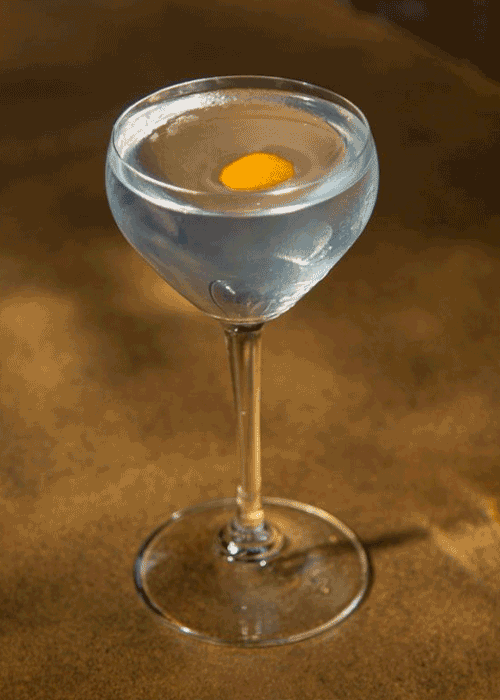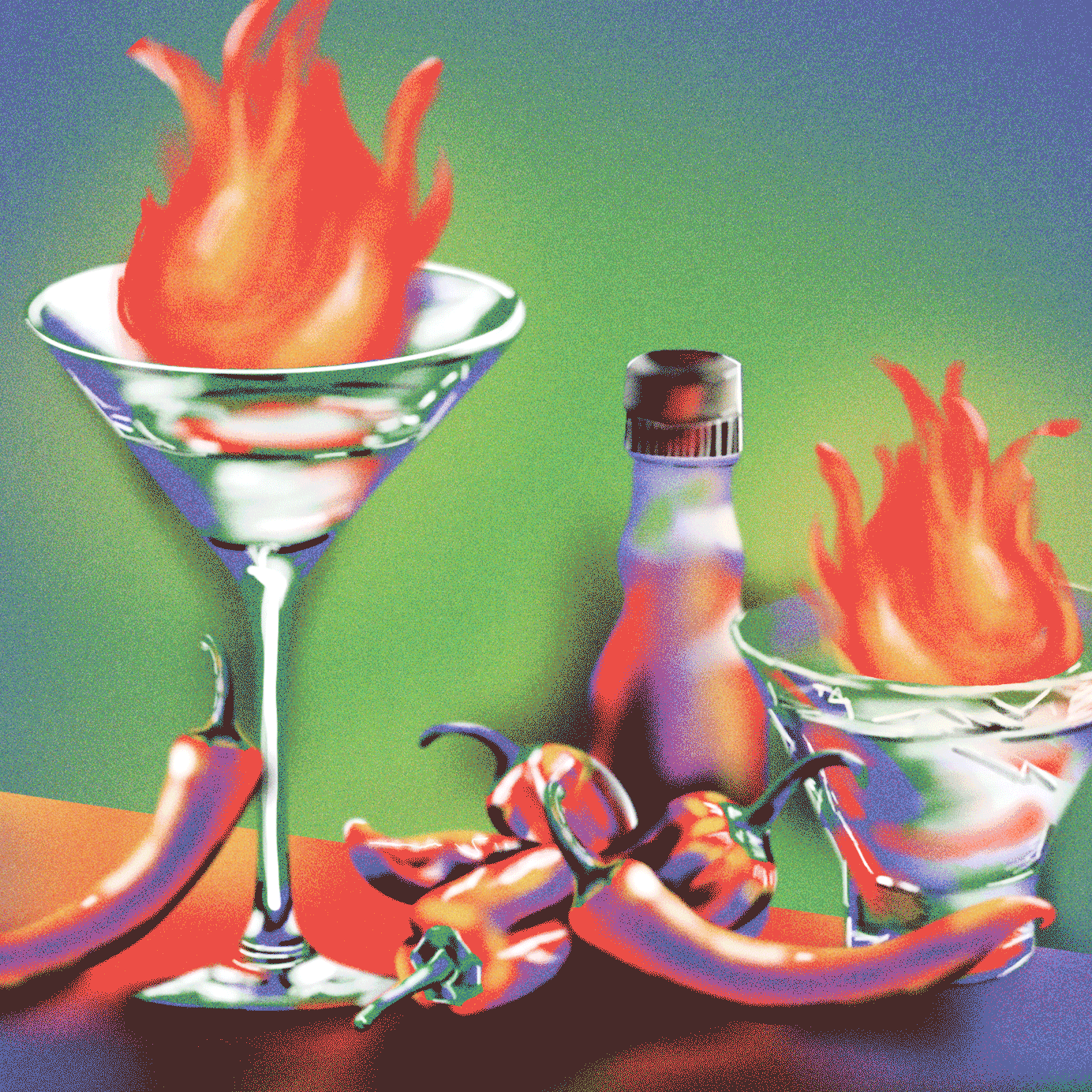In modern American watering holes, Spicy Margaritas are about as ubiquitous as barstools. And for many, they’re the platonic ideal of a sense-stimulating cocktail.
The classic’s typical blend of tequila, refreshing lime, and orange liqueur enjoys a fiery upgrade, usually via some sliced jalapenos or a Tajín-salted rim. At the center of this pleasure-pain paradox lies capsaicin, the active component that gives chili peppers their heat. But that compound that gives our beloved spicy Margs their sting is also tempered by sugar, fruit juice, and/or flavored liqueurs. Looking to feel something more, drinkers are now seeking something with more bite: enter the Spicy Martini.
Yes, the idea may sound like overkill. We love watching “Hot Ones” contestants sniffle and sweat their way to the last dab, assaulting their senses with something that can be pleasant in moderation. It’s tolerable, but is it enjoyable? The same could be said of the Martinis — the king, queen, prince, and pauper of boozy cocktails — which likely means most fans of the drink aren’t exactly seeking a conservative flavor profile in the first place.
“The Martini is a funny drink in general,” says Tyson Buhler, beverage director at Gin & Luck, which oversees Death & Co’s Denver, Los Angeles, and New York locations. “We love Martinis. We love talking about Martinis. It’s probably the most famous name of a cocktail out there. In reality, it’s a whole lot of booze in a glass. They’re very much in your face, and pretty aggressive drinks by nature.”
In other words, we like them because they hurt so good.
That’s why, in theory, adding more bite to a cocktail this bracing shouldn’t work — but it does. If done right, garnishing an already crazy-strong cocktail with a dot-dot-dash of a spicy tincture can issue a sadistic slap that invites you to thank it for the pain. And now, bartenders are bringing their more taboo-tasting notes mainstream.
The common gateway for many recipe developers has been, predictably, tequila. Eric Alperin, global director of beverage restaurants and bars at CultureWorks, tells VinePair that he did not intentionally set out to create a spicy Martini for New York City’s Verōnika, which re-opened in 2022. Ginn Choe, bar manager at the time of the restaurant’s opening, was formulating a Thai chili-based Firewater tincture for — you guessed it — a Spicy Margarita. The chilis, which are cooked down sous vide with Everclear, offered a “clean, more structured heat,” says Alperin, who realized the tincture was the dynamic punch the bar’s gin-based Martini was missing. Alperin added some complementary smoke to the aptly named Fire Lily, a stirred nod to Richard Boccato’s Water Lily (the duo shared time at the legendary Milk & Honey, and Boccato now owns New York’s Dutch Kills Bar), by pulling back the gin and adding mezcal to the delicate vermouth and crème de violette blend. The result: a stiff yet sophisticated elixir with just enough bite to tempt you into a second glass.
As with Verōnika’s happy accident, San Francisco bar and restaurant Causwells was led to its own Holy Trinity Martini by strolling through Tequila Valley. After the overwhelmingly positive response to a former menu’s spicy and dirty Martini infused with Guindillas — a pickled Spanish pepper co-owner Elmer Mejicanos compares to a banana pepper — the team sought to one-up themselves with a vodka-based option. Rather than waiting until the last step of the build to add some tongue-nipping fire, Mejicanos created the new cocktail with heat baked into every step.
He selected Stoli Elite for its pepper notes to serve as the drink’s base, which is then infused with the Cajun answer to sofrito, or what New Orleans locals refer to as the “Holy Trinity”: bell peppers, onions — Causwells’ are house-pickled — and celery. Manzanilla sherry and cracked black pepper join the spirit for salinity and a clean bite, respectively, then the blend is diluted, batched, and frozen until service. There, it’s poured and topped with three drops of the recipe’s final kick in the ass: a house-made chili oil composed of high-quality olive oil, salt, house-roasted Pasillas, Calabrian chilis, and a touch of Aleppo pepper.
For those more comfortable straddling the lower end of the Scoville scale, pepperoncinis, hot sauce, sweet peppers, and peppercorns of all shades have made appearances on hot menus recently. New Yorkers, it would appear, are masochists through and through: Columbus Circle Italian spot Bad Roman uses brine from the aforementioned green pepper in its Grey Goose-led offering, and The Mermaid Inn’s Hot & Dirty gets its fire and color from hot sauce and a pickled peppadew. Espelette pepper liquor and teeny Peruvian Sweety Drop peppers are the spicy stars in Temple Bar’s gin-based Salt & Pepper Martini, and Rockefeller Center’s swanky Le Rock uses green peppercorns in its dirty Au Poivre.
Despite the unforgiving directness of the Spicy Martini, balance is clearly key when marrying spirit and spice. If you’re attempting one at home, deciding what you’re looking to achieve in your cocktail can help dictate what heating agent best suits the spirit, especially when working with fresh or dried chilis.
“You’re getting two things from a chili: flavor and heat. Do you want the smoky flavor of an Ancho chili, or do you just want that kind of green freshness of a jalapeno?” asks Buhler. As the heat from a chili’s flesh or seeds will intensify the longer it steeps in the spirit, Buhler suggests adding the guts of one jalapeno to a bottle of your spirit of choice, and then tasting the infusion in 15-minute increments.
An infused spirit can be an easy at-home add for whenever a ‘tini craving calls — if made with a conservative (and patient) hand.
“You have to remember that chilies are just dangerous in general. They can be toxic, obviously, if not prepared correctly and used in the right amount,” warns Alperin. “Decades ago, I made my first infused vodka with chilies, and I put a lot of chilies in the bottle. I created a bomb.” Alperin also notes that though he’s no food scientist, he recommends sticking to smaller-sized peppers like Fresno and Thai chilis when experimenting with infusions at home, and that includes when making tinctures for cocktails like the Fire Lily.
To forgo the risky business, there’s a slew of hot, pepper-tastic products on the market ready to be stirred, like Ancho Reyes’ red and green chili liqueurs. “They both carry some spice to them,” says Buhler. “They could make for a really fun Martini-style drink.”
Fun, pain… when served in a coupe glass, they’re one and the same.
The Fire Lily
(Created by Eric Alperin for Verōnika in New York City)

Ingredients
- 1 ½ ounces Fords gin
- ½ ounce Vida mezcal
- ½ ounce Dolin Dry Vermouth
- ¼ ounce Cointreau
- ¼ ounce crème de violette
- 1 dash Ginn Firewater Tincture (recipe below)
- Garnish: 1 orange button
Directions
- Measure all ingredients into a chilled mixing glass.
- Add cracked ice and stir.
- Strain into a chilled coupe glass.
- Express oils from an orange button and use as garnish.
Ginn Firewater Tincture
(Created by Ginn Choe)
Note: Please wear nitrile gloves and protective eyewear when handling Thai chilis.
Ingredients
- 1 part weight Thai chilis, de-stemmed and split in half lengthwise
- 5 parts Everclear
Directions
- Combine Thai chilis and Everclear and sous vide for 2 hours at 158 degrees Fahrenheit.
- Strain chilis from the Everclear and discard.
- Cut the liquid with equal parts water and pour the firewater into an accurate dasher bottle.
